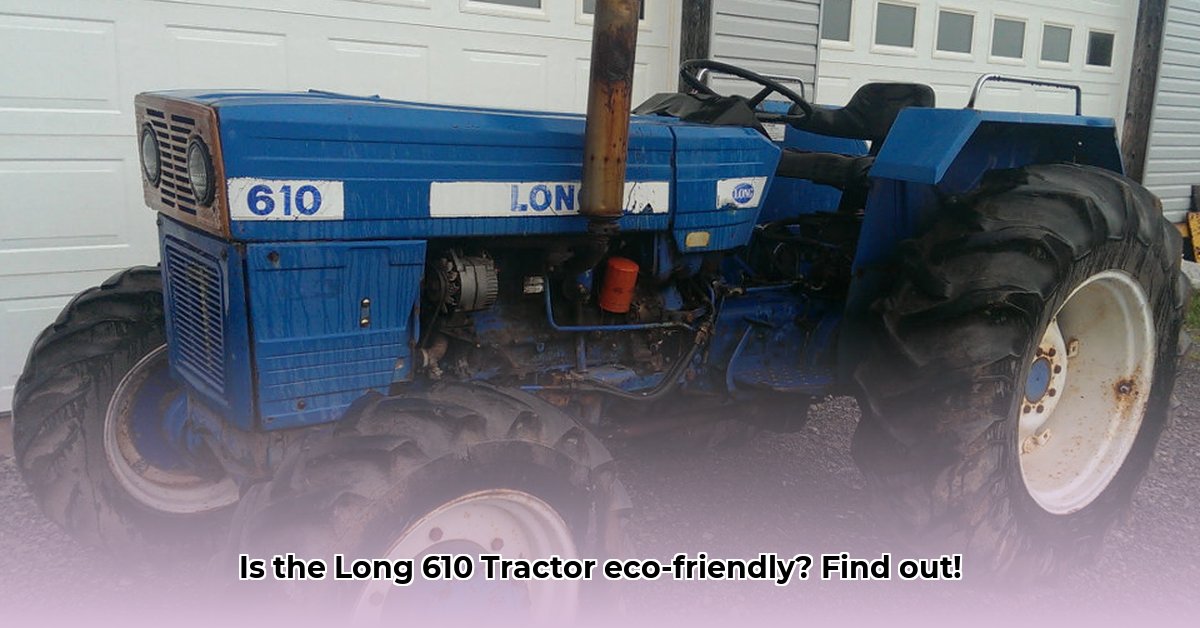
610 Long Tractor: A Blast from the Past – But Is It Sustainable?
The Long 610 tractor evokes images of simpler times and hard work. Manufactured between 1979 and 1990, this vintage machine begs the question: Can it compete with modern tractors while upholding sustainability principles? This review delves into its capabilities, limitations, and overall suitability for contemporary farming. For more tractor cost information, see tractor costs here.
Getting to Know the 610: Specs and Such
The Long 610 features a 3.6-liter, four-cylinder diesel engine producing approximately 64 horsepower—respectable for its era but modest by today's standards. Its eight-forward, two-reverse gear transmission is straightforward and effective. The hydraulic system holds about 4.25 gallons, and the fuel tank capacity is approximately 14.25 gallons (variations of roughly 0.05 gallons exist in reported specifications). But is this vintage powertrain truly sustainable?
Sustainability: The Million-Dollar Question
Assessing the Long 610's environmental impact requires crucial data currently unavailable. Information on fuel efficiency (gallons per acre worked) and greenhouse gas emissions is needed for a complete environmental analysis. This data gap hinders a definitive sustainability assessment.
Furthermore, the open operator station lacks modern safety features such as roll bars and protective cabs, introducing significant safety risks. This increases downtime and maintenance costs, impacting its economic sustainability. The challenge of sourcing parts and the unknown long-term maintenance costs add further complexity.
The 610 in Today's Farming World
The Long 610's relatively low horsepower likely limits its suitability for large-scale operations demanding speed and efficiency. Its performance across varying terrains (hills, mud, etc.) remains uncertain. While it might suffice for small-scale, low-intensity farming, its suitability needs careful consideration.
How to Assess the Environmental Impact of a Long 610 Tractor
Key Takeaways:
- The Long 610's age significantly impacts its sustainability. Its older technology contrasts sharply with modern, eco-friendly designs.
- Comprehensive evaluation necessitates analyzing fuel consumption, maintenance practices, lifespan, and end-of-life considerations.
- Comparing it to modern tractors reveals significant differences in fuel efficiency and emissions. How does this difference impact your operation's bottom line and environmental footprint?
- The tractor's operational history is critical for accurate assessment.
Performance and Reliability: A Mixed Bag
The Long 610 offers dependable performance in basic tasks like plowing and planting. While its fuel efficiency is relatively good for its time, recurring mechanical problems such as starting issues, leaks, transmission problems, overheating, and electrical faults significantly compromise operational efficiency and increase repair costs. This needs careful consideration, especially when compared to the relative reliability of newer models.
Assessing the Environmental Impact: A Practical Approach
Evaluating the environmental impact requires a systematic approach:
Fuel Consumption: Carefully track fuel usage under typical operating conditions and compare it to modern tractors' data. Higher fuel consumption directly correlates with increased greenhouse gas emissions, influencing your carbon footprint.
Maintenance and Repair: Document repair frequency and type. Frequent repairs increase parts consumption, manufacturing energy, and potential waste. Factor in parts availability and sourcing challenges. Could the time spent on these repairs be redirected to more profitable activities?
Lifespan and End-of-Life: Consider the tractor's expected lifespan. A shorter lifespan due to mechanical issues leads to faster replacement cycles, increasing environmental impact. Plan for responsible disposal or recycling.
Manufacturing Processes: Acknowledge the differences in manufacturing processes between the 1970s-80s and contemporary methods, impacting the overall environmental burden of the tractor's creation.
Operational Practices: Evaluate the impact of farming practices used with this tractor. Do they align with sustainable agriculture principles?
Comparative Analysis: Compare the Long 610's performance to modern, fuel-efficient tractors with emission-reducing technologies. What are the key differences in total environmental impact?
Pros and Cons: Weighing the Costs
| Pros | Cons |
|---|---|
| Robust performance in basic tasks | High frequency of recurring mechanical issues |
| Relatively simple design, easier repairs | Older technology; less fuel-efficient than modern tractors |
| Potentially lower initial purchase cost | Significantly higher long-term maintenance costs; potential for failure |
The Long 610 and Modern Sustainability
The Long 610's age and design limitations prevent it from incorporating modern sustainability features. Advanced technologies like GPS-guided systems for precision farming are absent, increasing fuel and resource use. While adaptable for sustainable farming, it may be less efficient and environmentally sound than newer equipment. Is this trade-off acceptable for your farming operation?